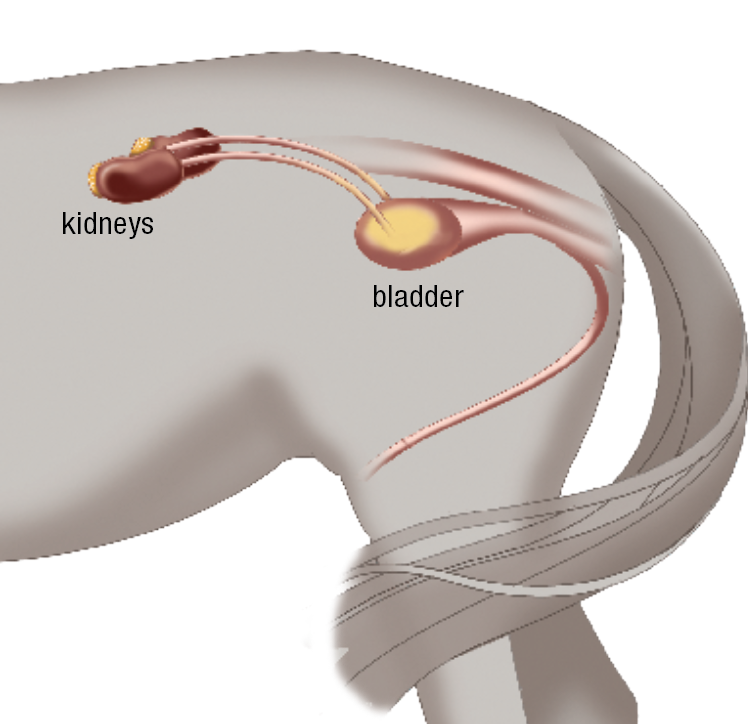What excessive urination in horses may mean
- October 3, 2022
- ⎯ Editors of EQUUS
Q: My 11-year-old Quarter Horse gelding has always been healthy, but lately I’ve noticed that he seems to be urinating more than usual. I don’t actually see him emptying his bladder more often, but I do find that I’m removing more wet bedding from his stall than normal. Is this something to be concerned about? He seems otherwise fine.Name withheld by request
A: Excess urination is called polyuria (PU). For a horse with PU to maintain a normal hydration state, he must also have polydipsia (PD), which is increased drinking. PU/PD can be a consequence of diet, a behavior problem or a sign of disease.
The kidneys filter waste products from the blood and eliminate these wastes in urine. They also regulate the volume of water in the body by producing urine that is either more concentrated than blood (deep yellow urine) or more dilute than blood (a clear urine that looks like water). More than 99 percent of the water filtered from blood by the kidneys is reabsorbed in the kidney tubules, allowing excretion of nitrogenous waste products at a 100-fold-or-greater concentration in urine as compared to blood.

Only a small decrease in reabsorption of water by the kidney tubules can result in a large increase in daily urine output. For example, if reabsorption of water by the kidney tubules decreases from 99 percent to 98 percent, daily urine volume will double—a fairly dramatic increase, leading to a wet stall.
The best example of how diet affects urine output is a newborn foal drinking mom’s milk. On a per- pound-basis, a foal ingests five times as much water as an adult horse. As a result, a healthy foal gets up from a nap, has a couple of drinks of milk and produces a clear, very dilute stream of urine 10 to 12 times a day. In contrast, a mature horse on an all-hay diet may void concentrated (deep yellow) urine two to three times a day.
The type of hay fed to mature horses can also affect urine output. For example, a legume hay (such as alfalfa or clover) is higher in protein and calcium and is more digestible than a grass hay. Thus, when horses are fed alfalfa they pass a larger volume of urine daily and make fewer manure piles. As a consequence, stalls for alfalfa-fed horses are often wetter, with a stronger ammonia smell (the result of protein breaking down), than stalls housing horses fed grass hay.
Click here to learn how changing your horses diet can reduce the ammonia he inhales.
In response to your specific question about your horse, it would be important to evaluate him for early chronic kidney disease (CKD), in which the kidneys can no longer produce concentrated urine. The first step would be to have your veterinarian collect a blood sample to measure urea nitrogen and creatinine concentrations, both waste products that may increase in the blood with CKD. If bloodwork suggests early CKD, kidney ultrasonography can be performed to further evaluate kidney size and changes in appearance. Unfortunately, CKD is a progressive disorder. Management includes a good diet to maintain body condition for as long as possible. Dialysis or kidney transplants in horses are not practical to pursue.
If blood values are normal, the next step would be to withhold water overnight to determine whether your horse can produce more concentrated urine with mild dehydration. You can perform this test by hanging a plastic milk jug (upside down, with the bottom cut off and padded) to collect urine samples at the start of water deprivation and again on the morning after water has been withheld for 18 to 24 hours.
If urine concentration increases to a normal value, then it is likely that your horse has psychogenic polydipsia, which means he drinks excessive amounts of water. This is usually a behavior associated with boredom from being confined in a stall for most of the day. If this turns out to be the problem, more turnout time and limiting water provided in the stall to two five-gallon buckets a day (twice the daily need for most horses) would be the solution. In most cases, psychogenic polydipsia goes away a few weeks after these management changes are implemented.
Even if your horse’s blood values are in the normal range, CKD would be suspected if he fails to produce more concentrated urine after water deprivation. Management would be the same as mentioned above. However, with early CKD, it is also important to avoid regular use of medications, primarily non-steroidal anti-inflammatory drugs like phenylbutazone (“bute”), flunixin meglumine (Banamine), and firocoxib (Equioxx) that could worsen kidney damage.
Harold Schott, DVM, PhD
Michigan State University
East Lansing, Michigan
Don’t miss out! With the free weekly EQUUS newsletter, you’ll get the latest horse health information delivered right to your in basket! If you’re not already receiving the EQUUS newsletter, click here to sign up. It’s *free*!








